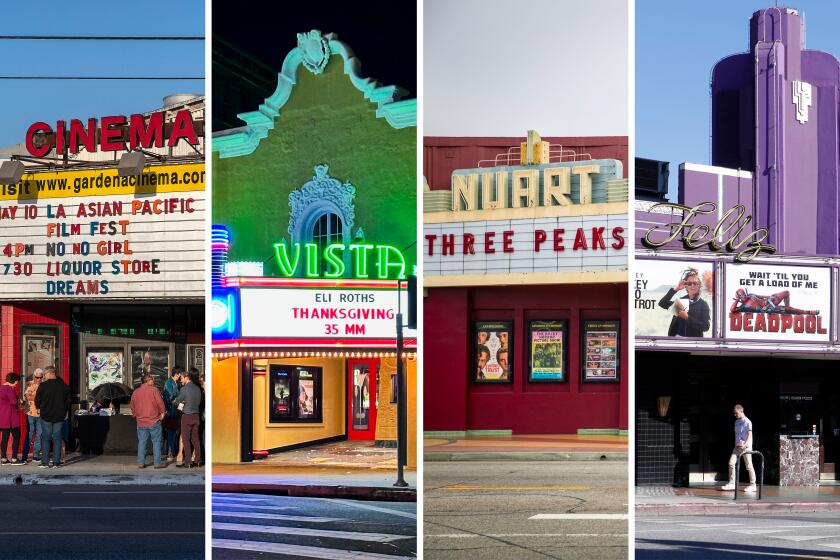Review: ‘Lee’ and star Kate Winslet bring the WWII photojournalist to hardened, complex life

- Share via
One of the animating questions in a film about a war correspondent is “Why?” Why do they do what they do? Why do they keep pushing, searching, exposing themselves to the suffering of war? It’s the primary question at the center of the new biopic “Lee,” about the famed photographer Lee Miller, who captured some of the most indelible images of the Holocaust as a reporter for Vogue during World War II. The question is posed by a young man (Josh O’Connor) interviewing a prickly Miller (Kate Winslet) about her life and work at her home in England in 1977, probing and provoking her in the hopes of extracting more profound answers than her usual caustic one-liners.
This framing device encircles just one remarkable chapter of the wild and colorful life of Miller, who lived so much both before and after the war. An American model and fine art photographer, she had already been the muse and lover of Man Ray, and had taught photography in New York City. When we catch up with her in the late 1930s, she’s gallivanting around the south of France with her friends, the group blithely unaware of the horrors that await with the rise of Adolf Hitler. In just a few short years, Miller will find the purpose that drives her, as well as traumas that almost destroy her.
Winslet, who produced “Lee” in addition to starring in it, has spent nine years developing the project, working with Antony Penrose, Miller’s son and the author of the book “The Lives of Lee Miller,” which was adapted by screenwriters Liz Hannah, Marion Hume and John Collee (Lem Dobbs also has a “story by” credit). The script is crafted in a traditional biopic format, with a twist that lends itself to Penrose’s experience writing about his mother’s life, trying to make sense of it.
We’ve mapped out 27 of the best movie theaters in L.A., from the TCL Chinese and the New Beverly to the Alamo Drafthouse and which AMC reigns in Burbank.
Ellen Kuras, a lauded cinematographer, television director and Oscar-nominated documentarian, makes her narrative feature directing debut on “Lee.” She and Winslet have known each other since Kuras shot “Eternal Sunshine of the Spotless Mind,” and her career as a cinematographer lends itself well to the subject of the female gaze in wartime. Miller seeks out the women in war, not just because she’s often shut out of male spaces, but because she is compelled to, and it soon becomes one of her artistic and journalistic obsessions.
Though Miller is often spoken about in the context of her famous affairs (Winslet has a lovely, sensual chemistry with Alexander Skarsgard, playing her husband, Roland Penrose), much of “Lee” is devoted to her working relationships and close friendships. In addition to Marion Cotillard and Noemi Merlant, who play Lee’s French confidantes, Andrea Riseborough co-stars as Audrey Withers, Lee’s editor and champion at Vogue, while Andy Samberg, in his first purely dramatic role, plays Davy Scherman, an affable New York photographer who becomes Lee’s professional partner as they report from war zones in France and Germany.

Samberg is a revelation here, delivering a subtle but incredibly moving performance. Winslet’s powerful and daring Lee, a force of nature, has her own fears and vulnerabilities, and she finds comfort in Davy, a rare man who feels safe enough to trust. During the liberation of France in 1944, she hears of missing people and they drive deep into Germany at the very end of the war to uncover the ugly reality of the Holocaust, relentlessly pushing forward in search of the truth.
“Lee” is anchored by a stunning extended sequence as Lee and Davy document the wreckage and human destruction of Hitler’s regime: Nazi suicide pacts, piles of corpses, concentration camps, prisoners and victims. It slowly builds to the capturing of an iconic photo of Lee bathing in Hitler’s bathtub, one of the most famous images of her. In the context of the film, it all makes perfect sense: After witnessing the human toll of Hitler’s murderous wake, it seems apt to humiliate or dominate him in this specifically feminine way. In the film, Lee is both the model and the author of this image and creating it is cathartic, leading to an emotional breakdown for Davy, delicately conveyed by Samberg. The flinty Lee remains stoic, speaking through her work, drowning her emotions in booze and pills.
Winslet is tremendous as always, embodying Lee’s gruff, no-nonsense persona, a hardened exterior underneath which a great wound still bleeds. It finally comes pouring forth in a stunning confession, illuminating every action that came before. This is a penetrating biopic, and while it may take a familiar shape, the pioneering woman at the center was anything but traditional.
Katie Walsh is a Tribune News Service film critic.
'Lee'
Rating: R, for disturbing images, language and nudity
Running time: 1 hour, 56 minutes
Playing: In wide release Friday, Sept. 27
More to Read
Only good movies
Get the Indie Focus newsletter, Mark Olsen's weekly guide to the world of cinema.
You may occasionally receive promotional content from the Los Angeles Times.











